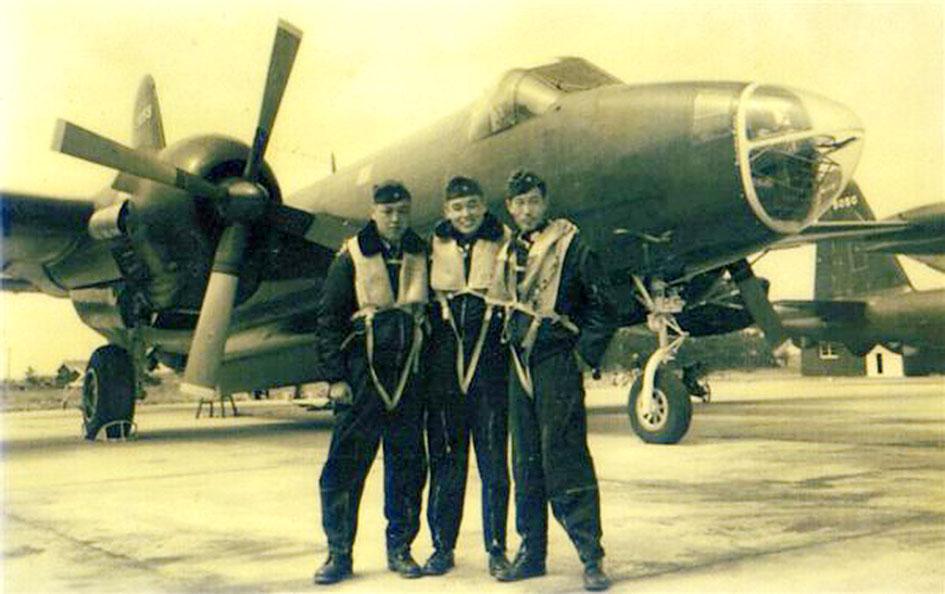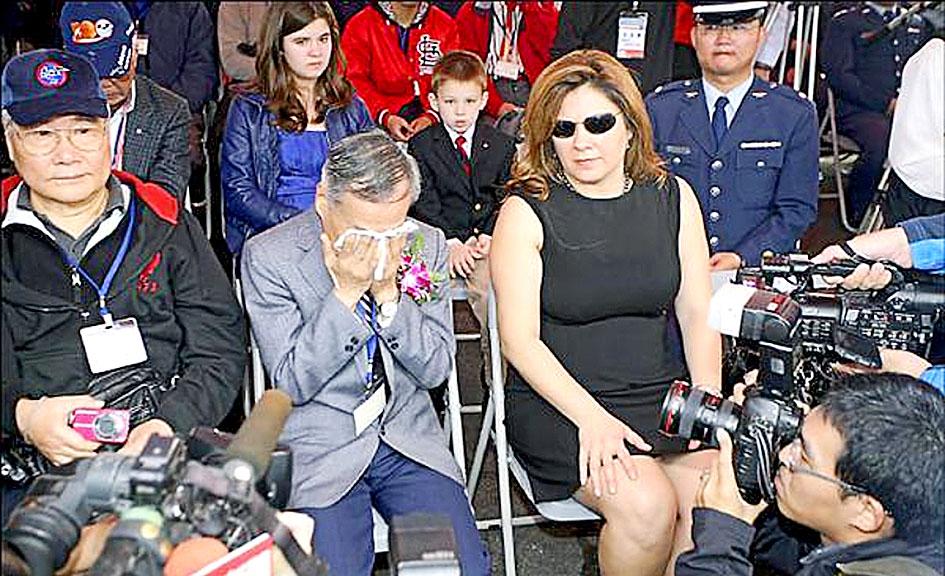Nov. 29 to Dec. 5
Every time Chu Chen (朱震) flew deep into enemy territory, he knew there was a good chance he wasn’t coming back. With two-thirds of the Black Bat Squadron — 148 members — perishing between 1953 and 1967, the odds were not on his side.
Chu had several brushes with death during his six years with the CIA-supported Bats, once surviving only because his Chinese attacker ran out of ammunition. But he pulled through each time and completed a total of 33 missions, the squadron’s second highest. He lived to the age of 86, receiving a presidential commendation after his death on Nov. 29, 2015.

Photo courtesy of Ministry of National Defense
Relatives of the deceased Bats tried for decades to find the remains of their loved ones in China and return them to Taiwan, but most of these attempts ended in failure. But there were successes, including the 14 crewmembers aboard a P2V-7U patrol aircraft captained by Chou Yi-li (周以栗), which was shot down over Jiangxi Province in June 1963. Through a chance encounter, their families found the crash site and, after cremating the remains, brought their ashes home on Dec. 4, 2001.
These efforts drew attention to the exploits of the Black Bat Squadron, which had remained largely unknown. Chu wept for his dead comrades during a commemorative event in 2012, telling the Liberty Times (the Taipei Times’ sister newspaper) that despite them taking on some of the most dangerous missions in the entire Republic of China (ROC) Army, many of their sacrifices were not acknowledged, and in some cases their families were never informed.
Former Black Bat Lu Te-chi (呂德琪) told the Liberty Times in 2007 that while they were more than willing to give their lives to protect the nation, former president Chiang Ching-kuo (蔣經國) promised them that the government would one day explain this top-secret program to the public.

Photo courtesy of Wikimedia Commons
“But after our missions were over, we still couldn’t drape the national flag over our dead comrades. We waited in despair, and eventually stopped talking about it. We thought that our stories would just be lost to the vicissitudes of history,” Lu said.
PERILOUS NIGHT FLIGHTS
It was not uncommon in the 1950s and 1960s for the ROC military to launch incursions into China, as president Chiang Kai-shek (蔣介石) still clung on to his fading dream of retaking China. Anti-communist brigades infiltrated the Chinese coast, while fighter planes flew deeper inland to drop agents and gather intel.

Photo courtesy of Wikimedia Commons
These efforts were supported by the US, who wanted information on China as part of its international anti-communism efforts. Taiwan’s 34th Squadron was established with CIA support, and its job was to fly secret low-altitude reconnaissance flights over China.
All operations were carried out at night, hence the nickname Black Bat Squadron. It was led by Air Force Intelligence Administration head General I Fu-en (衣復恩), who, due to the project’s secrecy, reported directly to Chiang Ching-kuo.
“Since I oversaw the Air Force’s special ops projects, some people equate my name with these legendary [squadrons],” I writes in his autobiography. “But the real people writing history were the young heroes who penetrated deep into enemy territory … They borrowed time from God, and risked their lives year round — but the public had no idea of this.”

Photo: AP
I notes that each plane typically had 14 crew members, so “the loss of each plane meant the death of 14 comrades and 14 broken families.”
The 34th Squadron was officially organized in 1958, but it had already been carrying out activities with CIA support since 1953. I was placed in charge of the program in 1956, and for the first three years, each plane made it back to Taiwan safely. In 1959, however, a B-17 captained by Hsu Yin-kui (徐銀桂) was shot down by the enemy and crashed near Enping in Guangdong Province.
I’s most memorable incident was in 1960, when enemy planes got a lock on a P2V-7U flown by Tai Shu-ching (戴樹清) in Henan Province. Tai flew the plane toward a mountain and made a sharp right turn, causing the tailing enemy fighter to crash. Tai flew 78 missions during his career — the most of any Black Bat. He also died in 2015.

Photo: Su Fu-nan, Taipei Times
RETRIEVING THE BODIES
The Black Bats flew their last mission in either 1967 or 1968, and were disbanded in December 1974, near the end of the Vietnam War.
Newspaper journalist and editor Fu Yi-ping (傅依萍) was a child when her father died as a crewmember of the plane that was hit near Enping. Nobody knew anything about the Black Bats then; all she knew was that her father lost his life during a mission.
At the time, contact between Taiwan and China was not allowed, but people could ask friends and family in the US to contact the Chinese authorities to find out about their relatives in China.
For example, Meng Hsiao-po (孟笑波), the wife of Lee Hun (李睯), had been searching for his body for decades. In 1985, Lee’s brother, a US-based academic, obtained an official report about the incident from the Chinese.
After martial law was lifted, details from the report were published in a Taiwanese military magazine. Fu’s childhood neighbors happened to see the article, and sent it to her mother. Through the author, they got in contact with Lee’s brother, who told them Meng had been trying to visit China ever since the end of martial law to retrieve her husband’s remains.
Through three feature articles in the United Daily News, one of them penned by Fu, she was able to locate the relatives of 13 out of 14 crewmembers. A group of them flew to Enping in December 1992 and, with the help of local authorities, they spent hours digging up their remains, having them cremated in China and returning with their ashes to Taiwan.
Since the 14 bodies had been buried together for 33 years, the families opted to keep them together in Taiwan’s Air Force Cemetery. They were officially laid to rest on March 29, 1993.
The remains of those on Chou Yi-li’s plane followed a similar fate. In 1999, former Black Bat Kao Yin-sung (高蔭松), who had emigrated to Canada, saw a report about Chinese ace pilot and war hero Wang Wen-li (王文禮), who happened to be the one who shot down the plane. Kao noticed that the dates and details of an incident Wang described were eerily familiar. Kao reached out to Wang, who confirmed the crash and gave him the exact location where it took place. It had been 36 years, and the former enemies made their peace.
After much negotiation, Chou’s family headed to Jiangxi and retrieved what was left of the bodies and belongings. They were similarly interred in the Air Force Cemetery on Dec. 10, 2001.
Those who are interested in learning more about this part of history can visit the Black Bat Squadron Memorial Hall in Hsinchu City, which was opened in 2009.
Taiwan in Time, a column about Taiwan’s history that is published every Sunday, spotlights important or interesting events around the nation that either have anniversaries this week or are tied to current events.

Oct. 27 to Nov. 2 Over a breakfast of soymilk and fried dough costing less than NT$400, seven officials and engineers agreed on a NT$400 million plan — unaware that it would mark the beginning of Taiwan’s semiconductor empire. It was a cold February morning in 1974. Gathered at the unassuming shop were Economics minister Sun Yun-hsuan (孫運璿), director-general of Transportation and Communications Kao Yu-shu (高玉樹), Industrial Technology Research Institute (ITRI) president Wang Chao-chen (王兆振), Telecommunications Laboratories director Kang Pao-huang (康寶煌), Executive Yuan secretary-general Fei Hua (費驊), director-general of Telecommunications Fang Hsien-chi (方賢齊) and Radio Corporation of America (RCA) Laboratories director Pan

President William Lai (賴清德) has championed Taiwan as an “AI Island” — an artificial intelligence (AI) hub powering the global tech economy. But without major shifts in talent, funding and strategic direction, this vision risks becoming a static fortress: indispensable, yet immobile and vulnerable. It’s time to reframe Taiwan’s ambition. Time to move from a resource-rich AI island to an AI Armada. Why change metaphors? Because choosing the right metaphor shapes both understanding and strategy. The “AI Island” frames our national ambition as a static fortress that, while valuable, is still vulnerable and reactive. Shifting our metaphor to an “AI Armada”

The older you get, and the more obsessed with your health, the more it feels as if life comes down to numbers: how many more years you can expect; your lean body mass; your percentage of visceral fat; how dense your bones are; how many kilos you can squat; how long you can deadhang; how often you still do it; your levels of LDL and HDL cholesterol; your resting heart rate; your overnight blood oxygen level; how quickly you can run; how many steps you do in a day; how many hours you sleep; how fast you are shrinking; how

When Taiwan was battered by storms this summer, the only crumb of comfort I could take was knowing that some advice I’d drafted several weeks earlier had been correct. Regarding the Southern Cross-Island Highway (南橫公路), a spectacular high-elevation route connecting Taiwan’s southwest with the country’s southeast, I’d written: “The precarious existence of this road cannot be overstated; those hoping to drive or ride all the way across should have a backup plan.” As this article was going to press, the middle section of the highway, between Meishankou (梅山口) in Kaohsiung and Siangyang (向陽) in Taitung County, was still closed to outsiders